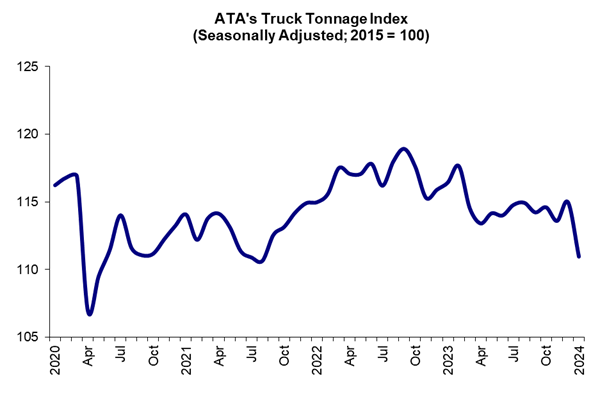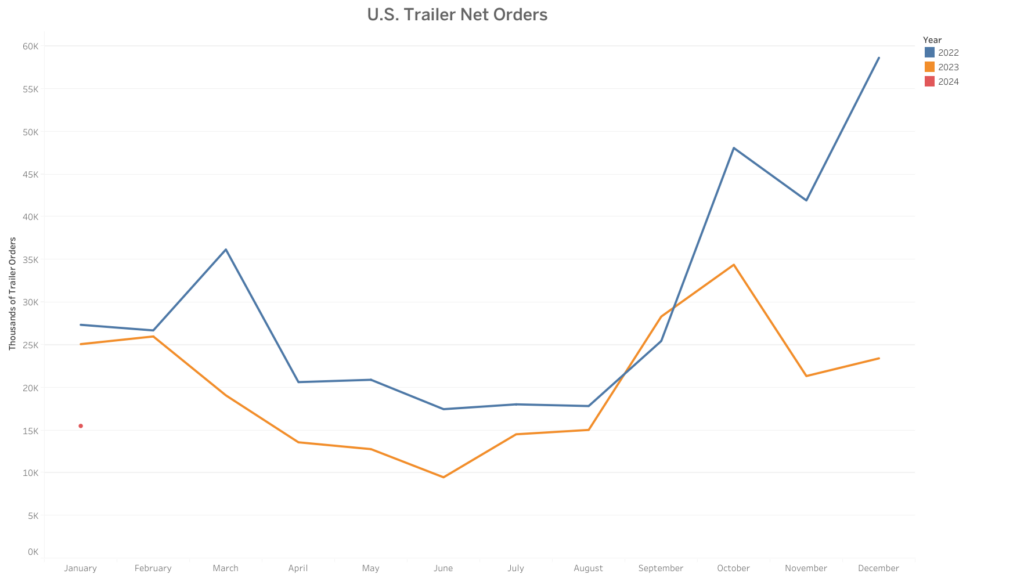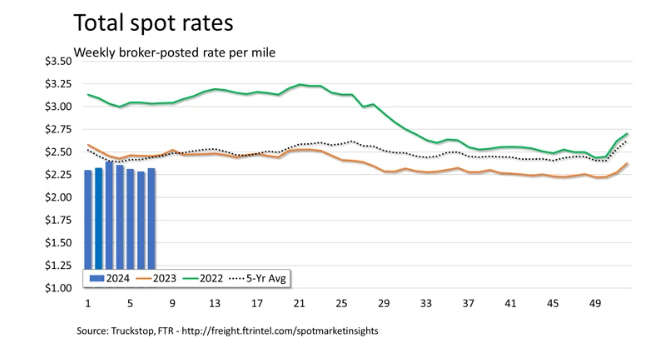Economic Trucking Trends: Trailer orders plummet as truck tonnage snaps ‘back to reality’
A recovery in the freight markets may have experienced a hiccup according to the latest data to come across our Inboxes.
U.S. for-hire truck tonnage fell sharply in January, throwing water on the notion the freight market is turning the corner. Total spot market rates were up, but only because of strength in the flatdeck sector; van and reefer rates were lower.
Trailer orders dropped sharply reflecting uncertainty among carriers and the potential end of pent-up demand from the supply chain-constrained market we’ve seen over the past couple years.

Truck tonnage snaps ‘back to reality’
U.S. for-hire truck tonnage dropped 3.5% in January, according to the latest data from the American Trucking Associations (ATA).
“January’s data was a snap back to reality for anyone thinking the freight market was about to turn the corner,” said ATA chief economist Bob Costello. “Bad winter weather in January likely hurt volumes, not to mention sharp drops in a number of drivers of tonnage including retail sales, housing starts and manufacturing output.”
The index was down 4.7% year over year; a troubling 11th straight YoY decrease.

Trucking conditions deteriorated in December
Trucking conditions worsened in December, according to FTR’s Trucking Conditions Index, which fell sharply from -1.35 in November to -4.31 the following month.
The decline was attributed to a higher cost of capital and deterioration of freight rates. FTR projects the index to remain below neutral market conditions through this year.
“We finally see indications that larger carriers are no longer absorbing the bulk of driver capacity displaced by failing small carriers, suggesting a steady tightening of capacity that eventually could spark a turn in the market,” said FTR’s vice-president of trucking, Avery Vise.
“If the recent upturn in diesel prices continues, the capacity drain among small carriers might accelerate. Even so, the industry will need stronger freight demand, and we still don’t see any significant inflection in volume until at least the second half of this year.”

Trailer orders plummet to start the year
January trailer orders fell 34% from December levels to 15,518 units, according to FTR. That was also 38% lower than last January numbers and 23% below the 2023 average.
Production was curtailed to the tune of 22% year over year, marking the lowest production total since January 2023.
“The relatively similar fall in both production and backlogs resulted in no material change to the backlog-to-build ratio, which stands at 7.1 months,” said FTR chairman Eric Starks. “This ratio is slightly elevated due to lower production levels and is above the historical average prior to 2020. A jump in the ratio is normal around the holiday season, and the overall picture is still of an industry that is continuing its move towards a pre-pandemic level of stability.”
ACT Research reported trailer orders of 13,700 units, down even further by 43% year over year. This came as no surprise to the industry forecaster.
“With the pent-up demand enjoyed by the industry during the past few years largely extinguished, a softer opening to 2024 meets expectations,” said Jennifer McNealy, director of commercial vehicle market research and publications at ACT Research. “Net orders are being challenged by a backdrop of weak profitability for for-hire truckers, and anecdotal commentary from trailer manufacturers throughout the past several months have been indicating this slowing, as they have shared that orders are coming but not at the same rapid pace that they have the last few years.”
McNealy added, “This month’s results continue to support our thesis that when fleets don’t make money, their ability and/or willingness to purchase equipment is muted. That said, the lower orders don’t indicate a catastrophic year in the offing, simply one that is on target to be less stellar than we’ve seen recently.”
In terms of elevated cancellations, McNealy said dry vans lead the way.
“Clearly, with markets swimming in capacity, no one needs a higher trailer-to-tractor ratio,” she said.

Spot market rates lifted by flatdeck segment
Total spot market rates edged upward for the week ended Feb. 16, but that was because of strength in the flatdeck segment, Truckstop reported. Van and reefer rates fell for the fourth straight week.
Truck postings rose only slightly, pushing the Market Demand Index to 62.3, its highest level in a month.
A report from Truckstop and Bloomberg Intelligence indicated spot market challenges appear near an end.
“The worst may be near for the North American truckload spot market,” said Lee Klaskow, senior freight transportation and logistics analyst at Bloomberg Intelligence. “Capacity could drop as rates hover near or below operating costs, which is crucial for the spot market to reach equilibrium.”
A survey of Truckstop customers found that: 68% of respondents felt volumes were lower in Q4, with 23% indicating they were flat; the majority felt current demand has reached its low point; only 14% of responding carriers said they’ll add tractors over the next six months; 46% expect rates to remain flat over the next three to six months with only 22% expecting improvement; and 43% admitted to being unsure about their status in the next six months.
“We share the sentiments of our customers and hold an optimistic outlook that spot market conditions will improve this year,” said Kendra Tucker, chief executive officer, Truckstop.
Have your say
This is a moderated forum. Comments will no longer be published unless they are accompanied by a first and last name and a verifiable email address. (Today's Trucking will not publish or share the email address.) Profane language and content deemed to be libelous, racist, or threatening in nature will not be published under any circumstances.